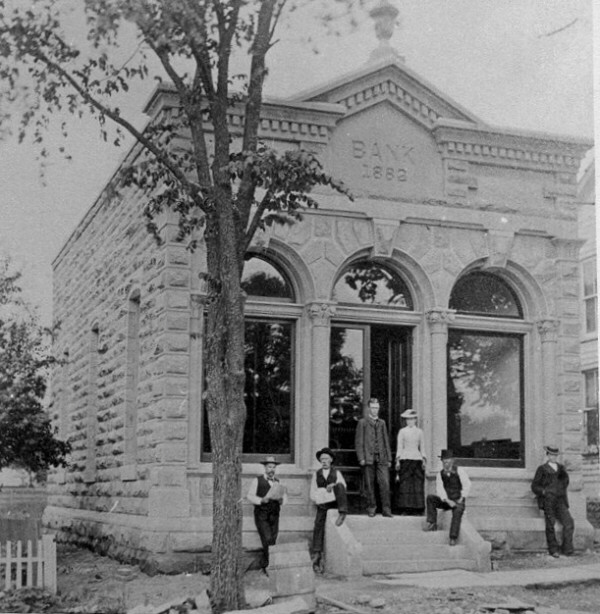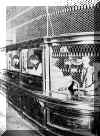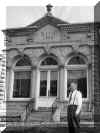| Because You Asked . . . . | ||||
 |
||||
|
Farmer's Bank - 28 E. Cherry
Street |
||||
|
Bank Saved by Buttons and Raccoon |
||||
|
In the January 7, 2016, edition of The Sunbury News, Lenny Lepola had a picture of the outside of Farmers Bank built of stone at 28 East Cherry Street where Tablerock Construction is today. Several asked if that was THE RACOON BANK. Yes, it was. Farmers Bank had a long history in Sunbury. The business began in 1872, the stone building was built in 1882. According to Carleton Burrer, large blocks of stone quarried along the Big Walnut Creek were deposited on the north side of the public square. A crew of Italian stone cutters were brought in to cut the stone into various shapes - even round columns, fluted pilasters and finals. The decorative pedestal for the peak was sculpted from a single block. It is now in the backyard of the former Burrer home at 46 N. Columbus Street. In 1983 when trenches were dug for lighting on the square, a quantity of spalls and stone chips which matched the stone on the bank were thrown up by the trencher. I won’t repeat the history Lepola ran two weeks ago. In 1905 Rudolph "Rudy" Burrer, son of Jakie and Amy (Gammill) Burrer, a graduate of Sunbury High School, educated at Dennison University, joined the Farmer’s bank staff. He served 65 years with the bank not including the time he served in th Army in WWI. In 1960 the stone bank was too small so a larger brick one was to replace it. The town added a second north door to the Town Hall and fixed the west room for banking. When he retired in 1965 Rudy was President and Chairman of the Board of Directors and his nephew Carleton Burrer was promoted to cashier. In 1965 Farmers merged with First National in Delaware and Carleton became a vice president and manager of the Sunbury office. He retired in 1974 ending over 70 years of Burrers with the bank. Later the bank became City National Bank which was purchased by PNC in 2010. If you have children on grandchildren who have completed the third grade in a Big Walnut school they will probably tell you about the raccoon. Sometime before electricity, bank robbers broke into the bank, dynamited the door off the free-standing metal vault but left with our taking a cent. On top of the vault and apparently out of sight of the robbers was a stuffed raccoon who became airborne during the explosion and hit at least one of the robbers scaring them so much they fled the bank and took none of the money. The raccoon was dusted off and returned to his spot of honor on the bank vault. When the wall vault was installed in the modern bank there was no place for the raccoon and no one wanted to throw it away. The janitor took it home in the mean-time. I first heard this tale from Rudy Burrer but thought it a little strange. During an International Fair the Community Library sponsored, Henry Stith told the same story to a Capital University professor collecting folklore. He continued, "When the wall vault was installed in the modern bank there was no place for the raccoon and no one wanted to throw it away. The janitor was Henry’s mother. The bank never asked for the raccoon back so the Stiths kept it. When Henry died in 1988, his widow Aleta gave the raccoon to the historical society for the Myers Inn Museum. Rudy Burrer also told the story about a day during the depression when Charles Armstrong was the manager in the Farmers Bank. Pearl Whitney worked in The Sunbury News next door to the bank. One morning she noticed men standing on the steps leading into the bank. When group began to grow and still the bank doors were not opened, Pearl took the change out of the News cash drawer and went home and got all the change she could find and added it to her canvas bank deposit bag. It did not look like much of a deposit so she filled the bag with her buttons. The coins in the bottom made it sound like she had a bag full of money. Pearl returned to the bank, pushed herself through the men to the locked door. She banged on the door shouting, "Mr. Armstong. Mr. Armstrong. Open up. How can a woman run a business without a bank?" The embarrassed men left. Mr. Armstrong did open the bank. That was the only attempted ‘run’ on the bank. Mr. Armstrong and Mrs. Whitney became good friends. So Sunbury had the only bank saved by buttons and a raccoon! You may visit them in Myers Inn Museum. |
||||
| More Farmer's Bank Photos: | ||||
|
Early Bank Employees |
||||
 |
Back to Front:
Charles Armstrong Owen (Deacon) Kimball Otis Kimball |
|||
|
Back to Front: |
|
|||
 |
Deep snow |
Rudy Burrer |
||
|
Postcard used as a promotional from the Farmers' Bank in 1914 |
_small.jpg) |
Postcard in Red Edward's collection | ||
|
1966 |
First |
|||
|
. . . .And Now You
Know |
||||
| Return to Local History Index |
(1/28/2016) |
|||

_small.jpg)

